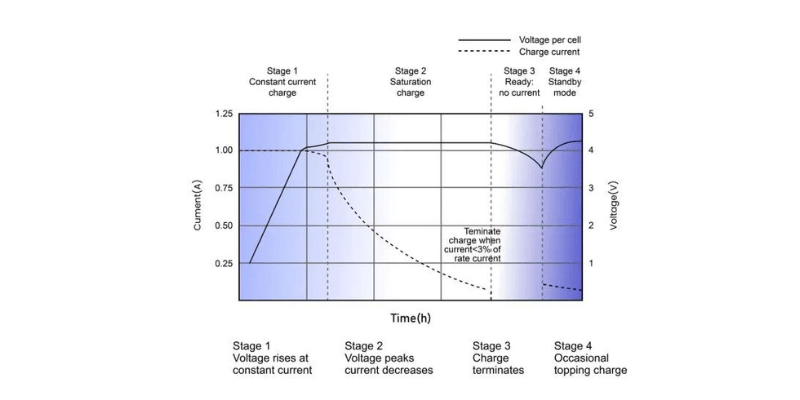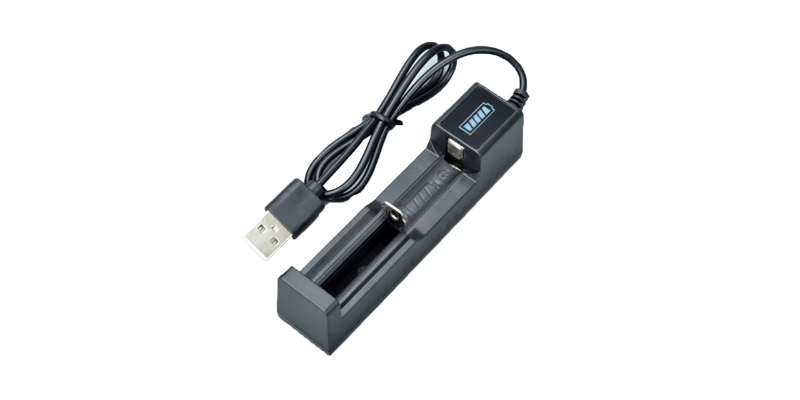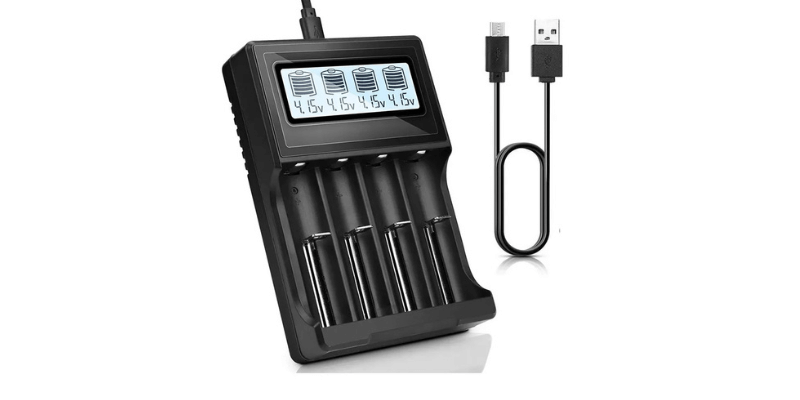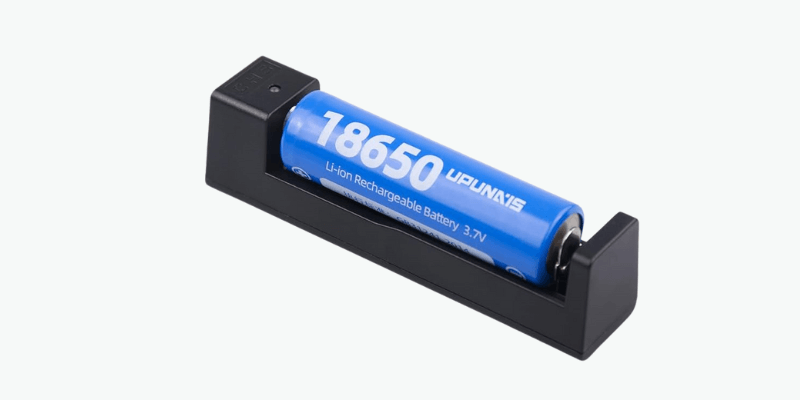Pelajari praktik terbaik untuk menagih Anda baterai 18650 dalam panduan ini. Pahami tahapan pengisian daya, pilih pengisi daya yang tepat, dan jelajahi strategi untuk meningkatkan umur panjang dan keamanan baterai 18650 Anda. Kuasai prinsip-prinsip penting untuk pengisian daya yang efektif guna memaksimalkan potensi baterai 18650 Anda.
18650 Tahapan Pengisian Baterai
Tahapan pengisian baterai 18650 meliputi tahapan arus konstan (CC) dan tegangan konstan (CV). Untuk mencegah pengisian daya yang berlebihan, lepaskan baterai setelah voltase konstantagetage. Biaya berkala yang kecil dapat mempertahankan kapasitas penuhnya. Diagram di bawah mengilustrasikan proses pengisian daya, dengan tahapan berbeda yang dibahas lebih lanjut.

Arus Konstan
Selama pengisian arus konstan, sel 18650 melepaskan dan menerima arus sebanyak yang disuplai, namun arus berlebihan dapat berbahaya. Tetap dalam batas yang ditentukan oleh lembar data. Pengisian daya standar biasanya didefinisikan sebagai 0,5 C (setengah kapasitas baterai). Untuk sel 2500 mAh, ini berarti arus pengisian standar 1250 mA.
Tegangan Konstan
Sel baterai 18650 sebagian besar terisi ketika tegangan mencapai 4,1 V atau 4,2 V, di mana arus yang masuk ke baterai berangsur-angsur berkurang.
Pengakhiran Biaya
Pengisian daya harus berakhir ketika arus turun di bawah nilai lembar data. Cabut baterai dari pengisi daya setelah terisi penuh untuk mencegah pengisian daya berlebihan dan kerusakan.
Jenis Pengisi Daya Baterai 18650
Pengisi Daya Satu Ruang
Pengisi daya satu wadah ideal bagi pengguna perorangan yang perlu mengisi daya baterai satu per satu. Meskipun tidak memiliki efisiensi multi-ruang, perangkat ini biasanya menyertakan fitur keselamatan dasar dan portabilitas. Model tingkat lanjut mungkin menampilkan layar LCD untuk menampilkan status pengisian daya atau pembacaan voltase.

Pengisi Daya Multi-Bay
Pengisi daya ini, tersedia dalam konfigurasi dua ruang hingga delapan ruang, dirancang untuk pengguna yang mengelola banyak baterai. Beberapa model dilengkapi slot pengisian daya independen dengan pemantauan kemajuan individual, memberikan kontrol dan efisiensi yang lebih besar kepada pengguna.
Pengisi Daya Cerdas
Pengisi daya pintar menawarkan pengaturan arus dan tegangan keluaran yang dapat disesuaikan untuk pengisian daya yang presisi. Mereka dilengkapi dengan fitur keselamatan seperti perlindungan overcharge, pencegahan korsleting, dan perlindungan polaritas terbalik.
Model tingkat lanjut mungkin juga menawarkan pengondisian baterai atau fungsi diagnostik untuk memastikan kesehatan yang optimal.
Pengisi Daya Cepat
Pengisi daya ini menggunakan teknologi seperti Quick Charge atau USB Power Delivery untuk mengurangi waktu pengisian daya secara signifikan. Namun, pengguna harus berhati-hati terhadap potensi dampak pada masa pakai dan kesehatan baterai karena peningkatan panas akibat pengisian daya yang lebih cepat.
Pengisi Daya USB
Pengisi daya USB menawarkan fleksibilitas dan mobilitas untuk mengisi daya 18650 baterai saat bepergian. Kompatibilitas USB memungkinkan pengisian daya dari bank daya dan port laptop.
Namun, arus dan tegangan keluarannya mungkin terbatas dibandingkan jenis pengisi daya lainnya.

Pengisi Daya DIY
Pengisi daya DIY menarik bagi para penggemar dan profesional yang mencari penyesuaian. Kit dan komponen memungkinkan pengguna untuk mengubah parameter pengisian daya, membuat pengisi daya yang disesuaikan, atau bereksperimen dengan pengisian dan pengelolaan baterai.
Bagaimana Cara Memilih Pengisi Daya Baterai 18650?
Memilih pengisi daya baterai 18650 yang tepat melibatkan faktor-faktor utama: kecepatan pengisian daya, kompatibilitas, fitur keselamatan, dan kualitas pembuatan secara keseluruhan. Anda juga harus mempertimbangkan kebutuhan spesifiknya, seperti portabilitas atau fitur-fitur canggih seperti LCD atau beberapa slot pengisian daya.
Kesesuaian
Pastikan pengisi daya dirancang untuk baterai 18650 dan kompatibel dengan ukuran dan bahan kimia seperti litium-ion atau litium-polimer. Ini mencegah kerusakan pada baterai saat pengisian.
Fitur Keamanan
Prioritaskan pengisi daya dengan mekanisme keselamatan seperti perlindungan harga berlebih, pencegahan arus pendek, dan pengaturan suhu. Sertifikasi seperti CE, UL, atau FCC menunjukkan kepatuhan terhadap standar keselamatan.
Kecepatan dan Mode Pengisian Daya
Evaluasi kecepatan dan mode pengisi daya. Beberapa pengisi daya menawarkan tarif variabel (0,5A, 1A, 2A) untuk menyesuaikan dengan kapasitas baterai yang berbeda. Pengisian cepat memang bermanfaat, tetapi mungkin memengaruhi masa pakai baterai.

Jumlah Tempat Pengisian Daya
Tentukan berapa banyak baterai yang akan Anda isi sekaligus. Pengisi daya satu rongga cocok untuk pengguna individu, sedangkan pengisi daya multi rongga lebih baik untuk mengisi daya beberapa baterai secara bersamaan.
Portabilitas dan Keserbagunaan
Jika portabilitas adalah prioritas, pilih pengisi daya ringkas atau yang kompatibel dengan USB. Pastikan pengisi daya cocok untuk berbagai lingkungan, seperti perjalanan atau penggunaan di luar ruangan.
Fitur Ramah Pengguna
Pertimbangkan fitur yang meningkatkan pengalaman pengguna, seperti layar LCD untuk status pengisian daya, antarmuka intuitif, dan indikator kesehatan baterai. Fitur-fitur ini berkontribusi pada kenyamanan dan kemudahan penggunaan.
Membangun Kualitas dan Daya Tahan
Saat memeriksa kualitas dan daya tahan pengisi daya baterai 18650, prioritaskan bahan bermutu tinggi seperti plastik ABS atau paduan aluminium. Pengisi daya dengan ABS yang diperkuat menawarkan ketahanan benturan yang sangat baik untuk penggunaan jangka panjang. Casing aluminium meningkatkan pembuangan panas dan kekokohan, sehingga berkontribusi terhadap keandalan jangka panjang.

Bagaimana Cara Mengisi Baterai 18650?
Sebelum mengisi daya baterai 18650, periksa kerusakan, kebocoran, atau kelainan bentuk untuk menghindari bahaya keselamatan. Kemudian ikuti langkah-langkah di bawah ini.
- Masukkan baterai dengan benar dengan menyejajarkan terminal positif (+) dan negatif (-) sesuai tanda pengisi daya.
- Pilih mode pengisian daya yang sesuai berdasarkan kapasitas baterai dan spesifikasi pengisi daya; kecepatan yang lebih lambat dapat memperpanjang masa pakai baterai.
- Pantau kemajuan pengisian daya menggunakan indikator atau tampilan dan keluarkan baterai setelah terisi penuh. Jangan tinggalkan baterai tanpa pengawasan saat mengisi daya untuk mengatasi kelainan apa pun dengan cepat dan mencegah panas berlebih atau korsleting.
- Isi daya di tempat yang berventilasi baik dan tidak mudah terbakar, jauh dari suhu ekstrem dan sinar matahari langsung. Ikuti pedoman pabrikan untuk waktu pengisian daya, tindakan pencegahan keselamatan, dan kompatibilitas untuk kinerja optimal.
- Setelah diisi, simpan baterai dalam wadah pelindung untuk menghindari korsleting atau kerusakan yang tidak disengaja.
- Periksa dan bersihkan terminal pengisi daya secara teratur untuk menjaga fungsionalitas dan efisiensi.

FAQ
Apakah Baterai 18650 Memerlukan Pengisi Daya Khusus?
Disarankan untuk menggunakan pengisi daya yang dirancang untuk baterai 18650. Pengisi daya khusus menangani voltase dan karakteristik pengisian daya baterai lithium-ion, memastikan pengisian daya yang aman dan efisien.
Berapa Arus Pengisian Optimal Untuk Baterai 18650?
Sebagian besar baterai 18650 dapat diisi dengan aman dengan arus 0,5A hingga 2A.
Berapa Daya Maksimum Baterai 18650?
Tegangan pengisian maksimum baterai 18650 adalah 4.2V.
Berapa Lama Untuk Mengisi Baterai 18650?
Waktu pengisian daya bergantung pada keluaran pengisi daya dan kapasitas baterai. Biasanya, pengisian penuh baterai 18650 memerlukan waktu beberapa jam.
Bisakah Saya Mengisi Baterai 18650 Dengan Pengisi Daya AA?
Jangan mengisi daya baterai 18650 dengan pengisi daya yang dirancang untuk baterai AA. Persyaratan pengisian daya dan voltase yang berbeda dapat menimbulkan bahaya keselamatan.
Artikel Terkait:

